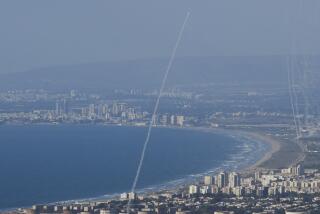U.S. Destroys 2 Libya Vessels in New Strikes : 3 Lost in 2 Days; Missile Site Hit Again
- Share via
WASHINGTON — U.S. warplanes and ships again clashed with Libyan patrol vessels Tuesday in the disputed Gulf of Sidra region of the Mediterranean Sea and attacked a coastal missile base for a second time, Pentagon officials said.
The officials, sorting through conflicting reports from three aircraft carriers operating north of the gulf, said that U.S. forces apparently sank two Libyan patrol boats Tuesday, bringing to three the number of vessels destroyed during two days of combat. No U.S. planes or ships have been hit, they said. There was no estimate of Libyan casualties.
The fighting broke out again Tuesday as determined U.S. forces continued to conduct military maneuvers in the central Mediterranean to assert the United States’ right to operate in what it considers international waters.
Kadafi Claims Entire Gulf
Col. Moammar Kadafi, who has drawn what he calls “the line of death” across the mouth of the gulf, claims that entire body of water as Libyan territory.
White House and Pentagon officials said that fighters and bombers from the U.S. 6th Fleet launched raids on Libyan ships and a Libyan missile radar site after at least six surface-to-air missiles were fired at U.S. aircraft over the gulf Monday.
Officials said Tuesday that the six projectiles fell well short of their targets, raising questions about whether they were properly fired.
But one military officer indicated that American efforts to jam the missiles’ radar guiding mechanism rendered the weapons useless. “We don’t have any casualties, do we? It’s an era of electronic warfare,” he said.
The fighting moved north of the gulf Tuesday, when the Yorktown, a Ticonderoga-class, 9,600-ton cruiser equipped with a super-sophisticated electronic warfare system, detected a slow-moving, missile-carrying patrol boat approaching it under cover of midnight darkness, Pentagon spokesman Robert B. Sims said.
The Libyan vessel suddenly picked up speed, accelerating to about 30 knots, and the Yorktown, operating 75 to 100 miles north of the gulf’s mouth, stopped it with what was described as Harpoon missiles. The Libyan vessel, which normally carries a crew of 27, was reported sunk, the Pentagon said.
Aided by electronic guidance systems, naval officers can fight long-distance battles at night, without ever seeing their targets, and pilots can detect approaching missiles--and respond to them--on the basis of radar reports. However, lacking actual sightings, officers may file duplicate reports or be unable to provide complete battle damage assessments.
Pentagon officials reported that, in addition to the ship attacked by the Yorktown, a smaller patrol boat, which Defense Secretary Caspar W. Weinberger had earlier said was “severely damaged” Monday, returned to port.
One Pentagon official said that the smaller boat was attacking from a position close to a merchant vessel Monday, making it difficult for the Navy pilots to retaliate without putting the civilian ship at risk.
The same Libyan patrol boat set out to sea again at dawn Tuesday and was fired upon by two A-6 light bombers from the carriers Saratoga and Coral Sea. Those vessels, along with the carrier America, form the nucleus of the 6th Fleet’s operations.
‘Boat Dead in the Water’
Tuesday, after U.S. forces attacked the patrol boat for a second time, the Pentagon assessment was: “Boat dead in the water and on fire, life rafts spotted and Libyan search and rescue” undertaken.
Still another Libyan patrol boat was reported to have been destroyed Monday.
Sims said that no warnings were given to the Libyan vessels that they faced attack. He added, in reference to the surface-to-air missile launchings and the behavior of the missile-equipped patrol boats: “We have been given ample evidence of hostile Libyan intentions . . . and we will defend ourselves.”
While some reports received by the Pentagon indicated that as many as five Libyan craft had been sunk, one senior official, speaking on the condition that he not be identified, said an “inventory” of the Libyan navy, presumably made by U.S. intelligence systems, determined that only three vessels were missing.
Soviet Warships in the Area
Meanwhile, three U.S. ships continued maneuvers in the gulf Tuesday, and at least four Soviet warships were operating in the area, while the flagship of the Soviet Mediterranean fleet remained in port in Tripoli.
Tuesday’s air attacks were launched against a Soviet-supplied SAM-5 missile site at Surt, on the western coast of the gulf. It was struck and damaged Monday, but repairs were believed to have been made and it began emitting electronic signals--attracting two A-7 attack aircraft from the Saratoga to strike it a second time.
The Pentagon was uncertain about damage inflicted at the site. Officials said, however, that the radar installation, which was the primary target of the U.S. strikes, generally is located at some distance from the missile launchers themselves, and the latter would not necessarily have been destroyed in the attack.
Weinberger said that after Monday’s attack, the radar, which guides missiles toward their target, was replaced.
No Soviet Protest Received
At a Pentagon news conference, the defense secretary said that the United States has received no protest from the Soviet Union, which is Kadafi’s principal supplier of missiles and aircraft.
But, he said, “any protest should be the other way around. We are exercising in international waters and somebody fired missiles at us.” The United States considers all waters beyond 12 miles from shore to be international territory. Kadafi claims the entire gulf, which measures 150 miles from its mouth to the farthest point on the Libyan coast.
White House spokesman Larry Speakes said that a senior Soviet diplomat was summoned to the State Department on Monday for a briefing on the developments.
Speakes and Weinberger have held out the possibility that the naval exercise, which began early Sunday north of the Gulf of Sidra and was scheduled to end on April 1, could end sooner if Adm. Frank B. Kelso II, commander of the 6th Fleet, decides that it can be halted.
On the other hand, the maneuvers could be extended, Speakes said, adding: “We can do what we want to.”
President Reagan received widespread support for the military action from Democrats as well as Republicans in Washington, although Rep. Patricia Schroeder (D-Colo.), a member of the House Armed Services Committee, asked after an Administration briefing for House members: “At what point are we egging each other on?”
Administration officials, since U.S. planes shot down two Libyan fighters in a conflict over the disputed gulf in 1981, are known to have sought an opportunity to respond to what they see as Kadafi’s support for terrorism in the Middle East, Europe and elsewhere.
Kadafi Compared to Capone
Sen. Richard G. Lugar (R-Ind.), chairman of the Foreign Relations Committee, compared the Administration’s dilemma with that of the federal government in the 1930s when it was seeking to jail mobster Al (Scarface) Capone.
“We couldn’t get Scarface straight on, but we did find that through the IRS (Internal Revenue Service) it was pretty effective,” Lugar said. “In a way, Kadafi has proven vulnerable in this respect. We don’t really want to take on and hurt a lot of Libyans per se, but we do want to get to the heart of Libyan authority, and perhaps in this way, we have succeeded.”
Sen. Robert C. Byrd (D-W.Va.), the Senate minority leader, said that “our country has no duty to turn tail and run if it is attacked in international waters. It has a duty to retaliate and it has done so.”
Arab nations appeared to unite behind Kadafi, with the Arab League’s Council of Foreign Ministers condemning what it called “American aggression against Libya.” At the United Nations, Malta, allied in the Mediterranean with Libya, called for an urgent meeting of the Security Council. No session was immediately scheduled.
Kadafi, meanwhile, appeared at a rally in Tripoli, the Libyan capital, telling a crowd at a rally: “It is a time of war, a time of confrontation. And we have decided the Gulf of Sidra is ours. We have decided this by sacrifice, by blood.” But he said the approximately 100 Americans living in Libya--most of them relatives of Libyans--were his nation’s “guests,” and added, “We are a civilized people.”
Times staff writers Eleanor Clift, Sara Fritz and Karen Tumulty contributed to this report.
Other stories and pictures are on Pages 12 and 13.
More to Read
Sign up for Essential California
The most important California stories and recommendations in your inbox every morning.
You may occasionally receive promotional content from the Los Angeles Times.










